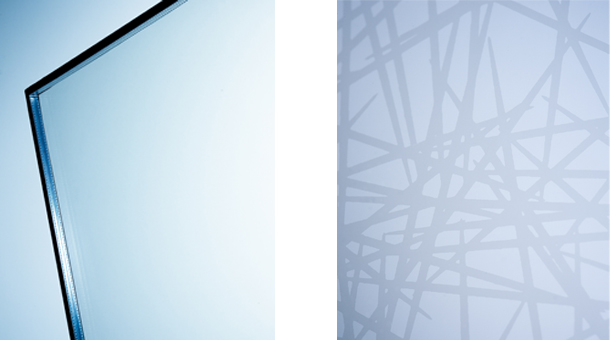Ornilux is visually transparent to humans (left image) but displays a life-saving collision-deterring pattern to birds (right image). Image courtesy of Ornilux.
In the world of The Expanded Environment, be it animal friendly design, animal-inclusive design or biosynthetics there are few resources as detailed, exhaustive and prescriptive as the design guides for bird-friendly architecture. Our avian cohabitors appear to be the first and most popular species to benefit from consideration in our built world – and it’s really no surprise. Bird collisions with glass and steel buildings results in untold millions of bird-deaths a year. As far as a visible indication of the negative impact of human construction goes, hundreds of dead birds on the ground, or at your door-step, is a show-stopper. There are several cities, outlined in a previous post linked here (tbd), that have adopted design guidelines for avian friendly buildings, but one company has taken the lead, stepping out from the pack, to develop a building material with the well-being of birds in mind.
Ornilux Bird Protection Glass, a product developed by Arnold Glas, is one of few (and the most transparent) architectural glass products currently on the market that is specifically designed to minimize bird-collisions with buildings. “Ornilux is a coating that is manufactured and applied to the surface of the glass” Says Lisa Welch, a Marketing and Sales Representative for Arnold Glas. “What makes it unique is its patterning and the fact that it reflects light mostly in the ultra-violet spectrum – a spectrum of light visible to birds and not to humans.” In terms of mitigating bird collisions, Ms. Welch continues that “it is the holy grail of bird-friendly glass. That is, it provides a bird-visible deterrent while maintaining high transparency and aesthetics for people. This solves one of the main challenges that has plagued wide-spread adoption of bird-friendly glass in the past – visible patterns in areas where clear glass views are desired”
The glass takes inspiration from spider-webs. Some species of spiders incorporate UV reflective strands in their webs, one purpose of which might be (among other things) to attract prey. But, more pertinently in this case, the UV reflective strands of silk may also work as a collision-deterrent by making the web visible to birds flying through their common environment. Researchers at Arnold Glas have taken inspiration from this technique and created a more-or-less criss-crossed pattern on the glass reflective mostly in the UV spectrum. Birds see the glass and much like a spider web, avoid collision. (More about the product testing and methodology here).
The material thus far has been successfully installed in a variety of locations, mostly in the US, Canada and Europe. Projects range from replacement of individual window panes in residential applications to an entire glass atrium on the campus of a prominent North Eastern Ivy-League school. “We don’t necessarily focus on any one market as Ornilux is a relevant treatment to mitigate bird collisions on any glass, though zoos and wildlife conservancies have shown a lot of interest.”
Ornilux, despite having been on the North American market since 2010 (it was released in Germany in 2006) still remains the only transparent architectural glass for bird collision reduction. Other glass products that are on the market are fritted, patterned, etched and laminated glasses that might reduce bird collisions but also reduce human visibility. “Interest and awareness growing” says Welch. “I think that especially among the sustainability, LEED and environmental movements, there is a growing desire for the next thing, and I think that issues surrounding wildlife conservation and wildlife in our urban area will be the next up-and-coming area that people are considering. As more and more people become aware of these conservation issues it has become increasingly popular.”
We here at The Expanded Environment applaud the work of the Arnold Glas and certainly feel that they’re on the right track. We are eager to see other architectural products on the market that have cross-species benefits and challenge architects and designers to always consider the well-being of the non-human agents in the built environment in their designs. More information on Ornilux can be found on at the NPR and Treehugger links below.
http://www.npr.org/2012/08/09/157792377/building-for-birds-architects-aim-for-safer-skies







